长江中下游成矿带是我国重要的铁-铜-金多金属成矿带,也是我国主要的铁矿产出地,按区域性成矿模式可分为鄂东南地区、赣西北(九瑞)地区、安徽沿江地区、江苏沿江地区(常印佛等,1991;翟裕生等,1992;唐永成等,1998)。在安徽沿江地区,大型铁矿床多分布于区内拗陷带内继承性断陷火山岩盆地及其边缘向断褶隆起的过渡区,与中生代中酸性或偏基性火山岩-次火山岩相关(常印佛等,1991;唐永成等,1998)。众多学者对区内铁矿床开展了地球化学研究,提出了铁矿床多种成因类型和成矿模式。归纳起来主要有以下几种成因类型:矿浆型(李秉伦和谢奕汉,1984;朱增青,1987;王跃等,2014;李延河等,2017;滕霞等,2018)、矽卡岩型(Xu and Lin, 2000;Zhou et al., 2011)、岩浆矽卡岩-热液叠加改造型(侯通等,2010;任广利等,2012;段超等,2017)、玢岩型(张乐骏等,2011;段超等,2012;Nie et al., 2017)。虽然隆起区内以铜多金属矿床为主,但也分布有大量铁矿床,这些铁矿床规模相对较小,研究相对较弱,对其成因和成矿作用存在较大争议(唐永成等,1998;许卫等,2011)。
以铜陵隆起区为代表,区内大中型铜多金属矿床有新桥铜金硫矿床、冬瓜山铜金矿床、铜官山铜铁金矿床等(臧文栓等,2004;陆建军等,2008;毛景文等,2009;Li et al., 2017; Zhang et al., 2017)。除大中型矿床外,该区分布有小型矿床33处,矿点96处,矿化点30处(周涛发等,2009)。这些数量众多的小规模矿体(矿化点):以铁矿化为主,如叶山铁矿主要产出镜铁矿跟褐铁矿(本文)、桃园铁矿主要产出含锌褐铁矿(杜森官等,2012);次之铜金铅锌矿化,如金口岭铜金矿床、包村金矿(周涛发等,2009;王剑波,2016)、白牡岭铅锌矿化较为特殊,该矿床还大量产出褐铁矿、镜铁矿(许卫等,2011);余下矿化点类型主要为煤、磷、锰等。
叶山铁矿是区内典型铁矿床之一,但是研究资料甚少,特别是对铁矿床的地质地球化学缺乏系统研究,故在矿床成因和形成机制方面争议较多,尚无统一认识。与之相关的成因类型主要有低温交代型(朱夏,1951)、矽卡岩型(郭宗山,1957)、沉积型(周涛发等,2009)、(层控)热液型(许卫等,2011)等。此外,该矿床主要呈层状赋存于中石炭统黄龙组与上泥盆统五通组之间,黄龙组为主要赋矿层位。与区内新桥、冬瓜山矿床类似,矿体的产出主要受石炭系地层层位控制,具有同生矿床的一些特征,前人对该层位的铜多金属矿床的成因主要持两种观点,即沉积-叠加改造型(常印佛等, 1991, 2012;唐永成等,1998;周涛发等,2010;侯增谦等,2011)和岩浆热液型(毛景文等,2009;张宇等,2013)。这两类观点之争的焦点在于成矿过程中是否经历了石炭纪(喷流)沉积成矿作用,及其对矿床形成的相对贡献。该层位中胶状黄铁矿层是众多学者认定的铜铁金多金属矿床的“矿胚层”,燕山期岩浆热液活动对该矿胚层的改造具有重要意义,同时该层位中菱铁矿受热变质作用形成磁铁矿是该类铜多金属矿床中铁矿化的重要存在形式(臧文栓等,2004)。区别于新桥、冬瓜山矿床,叶山矿区尚未发现该类建造,故矿区是否存在黄龙组沉积型铁质建造,及其建造类型和对该矿床的贡献量,成为该矿床众多成因观点争论的核心问题。为此,本文以叶山赤铁矿矿石为研究对象,通过激光剥蚀电感耦合等离子体质谱(LA-ICP-MS)对赤铁矿的化学组成进行详细研究,结合扫描电子显微镜(SEM)对矿石酸不溶相的微形貌观察,以期探讨叶山铁矿床成因、形成机制,为深入认识铜陵地区黄龙组沉积铁建造与该层位广泛存在的小型铁矿床之间的关系提供新的资料。
1 矿床地质背景叶山铁矿床位于长江中下游成矿带铜陵矿集区铜陵县钟鸣镇西南4km,矿区中心地理坐标:东经18°02′21″,北纬30°57′44″(图 1)。构造上处于下扬子褶皱带贵池-马鞍山断褶带中部的舒家店背斜北西翼,铜陵矿集区隆起北缘新桥矿田西北部(许卫等,2011),为矿集区内一小型铁矿床。

|
图 1 长江中下游成矿带大地构造简图(a,据Pan and Dong, 1999修改)及叶山铁矿地质简图(b,据安徽省地矿局321地质队,2003①修改) Fig. 1 Regional tectonic map of the Middle-Lower Yangtze River Valley Metallogenic Belt (a, modified after Pan and Dong, 1999) and geological schematic map of Yeshan iron deposit (b) |
① 安徽省地矿局321地质队.2003.安徽省铜陵县钟鸣镇叶山铁矿储量核实报告
矿区出露地层有上泥盆统五通组、中石炭统黄龙组、上石炭统船山组、下二叠统栖霞组及上覆的第四系沉积物(图 2a)。五通组下段主要为石英砂岩夹粉砂岩、含赤铁矿粉砂质页岩、页岩(图 2b, c);上段为细砂质粉砂岩、粉砂岩、泥质粉砂岩、粉砂质页岩夹石英砂岩。顶部纵向逆断层发育,致使五通组及黄龙组残缺不全,后者在部分地段缺失。黄龙组岩性为白云岩。船山组为球状灰岩,生物碎屑灰岩。栖霞组下段主要为生物碎屑灰岩,底部粉砂质页岩,含炭砂页岩;上段为生物碎屑灰岩、含燧石团块灰岩、含燧石结核及条带灰岩,夹燧石层。岩浆岩主要是中生代的花岗闪长岩、闪长斑岩小岩株、岩脉,发生强烈风化作用(图 2d)。

|
图 2 叶山铁矿野外地质特征 (a-c)叶山矿区出露的主要地层;(d)矿区出露高度风化的岩体及岩体接触带上蚀变矿物的褐铁矿化;(e、f)矿体围岩;(g-i)分别为矿区蚀变类型:绢云母化,大理岩化及其接触带上蚀变矿物的褐铁矿化,矽卡岩化 Fig. 2 Field photographs of Yeshan iron deposit (a-c) main strata exposed in the Yeshan mine area; (d) highly weathered magmatic rocks and limonitization from altered minerals in the contact zone; (e, f) country walls of ore body; (g-i) alteration assemblages from the mine area: sericitization, marbleization and limonitization from altered minerals in the contact zone, skarnization, respectively |
矿床主要由北东-南西向展布的5个矿体组成,沿叶山冲至大涝一带分布,矿体长70~300m,宽5~50m。多数铁矿体呈层状、似层状产出于层间断裂带与东西向次级叠加褶皱的轴部,矿体顶板为中石炭统黄龙组或上石炭统船山组,底板为上泥盆统五通组。本次采样点为No.Ⅴ矿体(图 2e),顶板为黄龙组,底板为五通组(图 2f),矿体走向与地层走向基本一致,明显受地层层位控制,黄龙组为主要赋矿层位。区内围岩蚀变微弱,底板围岩发生绢云母化(图 2g),接触带发生大理岩化(图 2h)、矽卡岩化,并发现有顺层分布的微晶黄铁矿(图 2i)。矿床中的金属矿物主要为赤铁矿(镜铁矿)、针铁矿,伴有磁铁矿及少量黄铁矿;非金属矿物以石英为主,深部可见矽卡岩矿物黑柱石。矿石主要以片状、针状结构为主,次为交代残余结构;构造以致密块状、条纹状构造、松散土状为主。
2 样品采集与实验方法 2.1 样品采集样品采自铜陵叶山铁矿床的露天采坑。根据矿石中赤铁矿的粒径、结构及共生矿物组合特征将赤铁矿分为三大类:第一类隐晶质赤铁矿Hem 1,与石英或粘土矿物共生,副矿物有金红石,多呈块状(图 3a-c),或与第二类型共同构成条带状构造(图 3d)。第二类为与磁铁矿共生型显晶赤铁矿Hem 2,具有明显交代结构,即早期磁铁矿被后期赤铁矿交代,赤铁矿保留了磁铁矿的晶形(图 3d, e),或呈放射状集合体(图 3f)。第三类为片状显晶赤铁矿Hem 3,又称之为镜铁矿,呈自形板片状集合体,块状或脉状构造,块状矿石矿物组成基本为镜铁矿,脉状矿石中镜铁矿多与石英共生。矿区表生风化严重,多伴生褐铁矿(图 3f-h)。由于矿区采矿历史悠久,故难以详尽描述各类矿石空间产状及穿插关系。

|
图 3 叶山铁矿不同类型的赤铁矿偏光显微镜或手标本照片 (a)隐晶质赤铁矿(Hem 1,样号YS-12);(b)Hem 1酸不溶物提取的石英颗粒和金红石;(c)隐晶质赤铁矿Hem 1(样号YS-8);(d)隐晶质赤铁矿(Hem 1)与显晶质赤铁矿(Hem 2)呈条带分布(样号YS-2);(e)为(d)条带部分放大,显示赤铁矿交代磁铁矿;(f)放射状显晶赤铁矿(Hem 2),显示赤铁矿交代磁铁矿(样号YS-6);(g-i)显晶质赤铁矿(Hem 3,样品分别为YS-11、14、19).矿物缩写:Hem-赤铁矿;Qtz-石英;Kln-高岭石;Rt-金红石;Mag-磁铁矿;Lm-褐铁矿;V-孔隙 Fig. 3 Photomicrographs or sample photos of different hematite from Yeshan iron deposit (a) cryptocrystalline hematite (Hem 1, sample YS-12); (b) acid-insoluble components containing of quartz and rutile extracted from Hem 1; (c) cryptocrystalline hematite (Hem 1, sample YS-8); (d) banded structure (sample YS-2) containing of cryptocrystalline hematite (Hem 1) and phanerocrystalline hematite (Hem 2); (e) close-up view of (d), showing magnetite was replacing by hematite; (f) radial phanerocrystalline hematite (Hem 2), showing magnetite was replacing by hematite (sample YS-6); (g-i) phanerocrystalline hematite (Hem 3, samples YS-11, 14, 19). Mineral abbreviation: Hem-hematite; Qtz-quartz; Kln-kaolinite; Rt-rutile; Mag-magnetite; Lm-limonite; V-void |
本次实验主要分为两个部分:其一是对隐晶质赤铁矿矿石样品(Hem 1)的酸不溶物做扫描电子显微镜(SEM)微区观察,将上述样品轻轻捣碎,用1M盐酸羟胺溶液(溶剂为20%盐酸),固液比为1g:100mL,水浴锅60℃加热12h,离心移去上清液,反复溶解直至上清液保持无色,对剩余酸不溶物进行扫描电子显微镜(SEM)观察。其二是对不同类型矿石光薄片观察后,用酒精擦洗,除去样品表面可能粘附的褐铁矿化,再进行激光剥蚀电感耦合等离子体质谱(LA-ICP-MS)分析。
2.2.2 SEM将样品酸溶后的酸不溶相置于样品台的导电胶上,在专用喷金装置中喷金120s,进行SEM图像及EDS分析。SEM在合肥工业大学分析测试中心完成,仪器型号为JEM-2100F。
2.2.3 LA-ICP-MSLA-ICP-MS分析在合肥工业大学资源与环境工程学院矿床成因与勘查技术研究中心矿物原位分析实验室完成,仪器为Agilent 7900四级杆质谱,激光剥蚀系统为Analyte Excite 193nm准分子激光。测试过程中以氦气为载气,束斑35μm,脉冲频率6Hz,能量6~10mJ/cm2,每个样点测试时间为60s,包括空白背景采集20s,样品连续剥蚀采集40s。本次实验采用无内标法,外标采用GSE-1G、GSC-1G和BCR-2G,实验数据由软件ICPMSDataCal(Liu et al., 2008)处理得到,主量元素和微量元素的测试误差分别为5%和10%。
3 实验结果 3.1 SEMSEM下YS-2、YS-8中石英粒径为2~600μm,磨圆度差,棱角分明,YS-12中石英颗粒多小于100μm,磨圆度差,且表面凹凸不平。YS-2中条带状石英颗粒表面发育阶梯状菱形生长纹,且小孔洞较为发育,并被亚微米级不规则细颗粒石英包围,使得表面凹凸不平,多孔隙(图 4a, b),局部石英颗粒具有平整边界及平行状生长纹(图 4c)。YS-8中石英颗粒,整体呈棱角状,但断面微平整,具有轻微的直线状细凹槽及弯曲状低凸起(图 4d),发育大量长条状“V”型凹痕,凹痕面上有粗糙、凹凸不平的硅质沉淀(图 4d-g)。YS-12中粗颗粒石英表面沉淀有大量的二氧化硅小球,与石英共生的高岭石呈不规则片状(图 4h, i)。
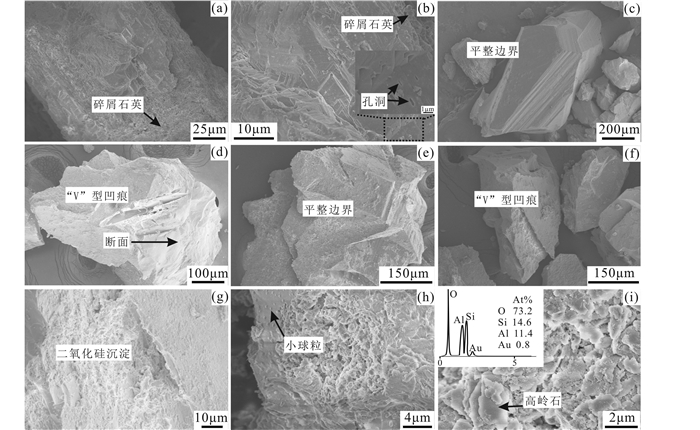
|
图 4 隐晶质赤铁矿(Hem 1)矿石中石英扫描电镜图像 (a-c)样品YS-2;(d-g)样品YS-8;(h-i)样品YS-12 Fig. 4 SEM images of quartz from the cryptocrystalline hematite ore (Hem 1) (a-c) sample YS-2; (d-g) sample YS-8; (h-i) sample YS-12 |
主量元素分析结果表明(表 1):Hem 1(YS-8)中FeO含量为94.50%~95.31%;SiO2、Al2O3、TiO2分别达到1.23%~1.77%、0.49%~0.81%、0.15%~0.20%;而MgO、MnO、CaO仅分别含有0.01%、0.02%、0.03%左右。相对于Hem 1,Hem 2具有较高的全铁含量(95.50%~96.53%),而TiO2、MgO、CaO含量偏低,SiO2、Al2O3、MnO含量变化幅度较大,如Al2O3、MnO,在YS-6中含量明显高于YS-2。该类型矿石中出现的磁铁矿在主量元素上与其共生的赤铁矿基本保持一致。Hem 3中全铁含量为94.82%~96.78%,而TiO2、MgO、CaO含量偏低,SiO2、Al2O3、MnO含量变化幅度较大,并可大致划分为两类:一类以高Al2O3(0.14%~0.91%),低MnO、SiO2为特征(如YS-11、19);一类以高MnO(0.15%~0.17%)、SiO2(0.52% ~0.91%),低Al2O3为特征(如YS-14)。
|
|
表 1 叶山铁矿床中赤铁矿/磁铁矿LA-ICP-MS分析结果(主量元素:wt%;微量元素:×10-6) Table 1 LA-ICP-MS analysis results of Hematite/magnetite in the Yeshan iron deposit (major elements: wt%; trace elements: ×10-6) |
微量元素特征:相对于Hem 2、Hem 3,除元素Ga(2.01×10-6~2.41×10-6)、Ge(1.18×10-6~1.47×10-6)、Mo(2.93×10-6~6.14×10-6)及W(15.78×10-6~22.66×10-6)含量偏低外,其余检测元素(V、Cr、Co、Ni、Cu、Zn、Sr、Ba、Sn、Pb)在Hem 1中含量都较高。Hem 2中元素Cr、Ni、Cu、Ge、Mo、Sn、Pb含量较低,不同样品差异变化较小;而元素V、Co、Zn、Ga、Sr、Ba、W等出现明显差异变化,即这些元素在YS-6中含量高于样品YS-2(W元素相反)。在Hem 2类型中,共生的磁铁矿在YS-6中与赤铁矿在微量元素组成差异不明显,而在YS-2中某些元素差异较大,如Co、Cu、Zn、Sr、Ba、Pb。Hem 3中检测元素含量普遍偏高,且元素含量变化大,这不仅体现在不同样品之间,还表现于同一样品中,如Cr、Co、Ni、Cu、Sr、W。
Hem 1(YS-12)中由于隐晶质赤铁矿与高岭石、碎屑石英紧密共生,其测试结果含有较高的SiO2、Al2O3值,待测的微量元素含量也偏高,故与其他赤铁矿不具可比性。但某些可作为参考,如Co/Ni比值小于1。
4 讨论 4.1 石英微形貌及微结构特征对物源的指示作用二氧化硅小球粒多形成于低能环境,如潮间带,此时石英颗粒与过饱和二氧化硅水溶液接触,在其表面沉淀细小石英颗粒(Higgs, 1979;Vos et al., 2014);扁平解理面是一种断面,是石英颗粒受到冲击或压力形成的,多见于风成或冰川环境(Krinsley and Doornkamp, 1973;Vos et al., 2014);不规则碎屑状高岭石可能反映陆源搬运沉积。这些未受后期热液影响的组分及Hem 1矿石的产状反映了叶山早-中石炭世海陆交汇的古地理环境(叶春林等,2010)。而叠加在这种石英颗粒表面的是大量长条状“V”型凹痕及平整的规则晶体边界,说明这些石英颗粒受到了热液作用的影响,发生了重结晶作用。
4.2 赤铁矿化学组成对物源的指示作用在SiO2-MnO相关性图解(图 5a)中,可大致地将Hem 2、Hem 3划分为两类:即低SiO2、MnO系列,如Hem 2(YS-2)、Hem 3(YS-11、-19);和高SiO2、MnO系列,如Hem 2(YS-6)、Hem 3(YS-14)。但在MnO-Al2O3相关性图解(图 5b)中,Hem 2可划分为低MnO、Al2O3系列(YS-2)和高MnO、Al2O3系列(YS-6),而Hem 3可划分为低MnO,高Al2O3系列(YS-11、19)和高MnO,低Al2O3系列(YS-14)。低Ga含量可能反映低程度的水岩反应(Huang et al., 2016),因此在SiO2-Ga相关性图解(图 5c)中,除Hem 2(YS-2)外,Hem 2、Hem 3都具有较高的Ga含量,明显有别于Hem 1,说明绝大多数Hem 2、Hem 3是在热液活动下的产物。在Co-Ni相关性图解(图 5d)中具有同样特征,Hem 2(YS-2)、Hem 3(YS-11、-19)的Co/Ni比值小于1.5,而Hem 2(YS-6)、Hem 3(YS-14)的Co/Ni比值远大于1.5。Pb-Zn、Cu-Ge相关性图解(图 5e, f)无明显规律,说明这些亲硫元素在热液体系中优先进入硫化物中(Dare et al., 2012;Zhao and Zhou, 2015),从而导致这类元素在铁氧化物中具有不相容性。叶山赤铁矿部分样品中出现异常高的W,但在W-MnO、W-CaO相关性图解(图 6a, b)中并未出现正相关性,由此排除黑钨矿、白钨矿的独立物相以包裹体形式存在。在W-MnO相关性图解中,亦可类似地将Hem 2、Hem 3划分为两类:即高W、低MnO系列,如Hem 2(YS-2)、Hem 3(YS-11、19);和低W、高MnO系列,如Hem 2(YS-6)、Hem 3(YS-14)。近年来Al、V和Ti元素广泛被用来指示成矿温度(Cabral and Rosière, 2013;Chung et al., 2015),本文Al2O3-TiO2、TiO2-V二元图解(图 6c, d)都具有分散性,表明不太适合作为指示该矿床成矿温度的指标。特别地,在以上的图解中,Hem 1的分布都比较集中、独立,与Hem 2、Hem 3的分布基本不重叠;Hem 2与Mag在YS-6中分布相对吻合、靠近,而在YS-2中分布基本不重叠。
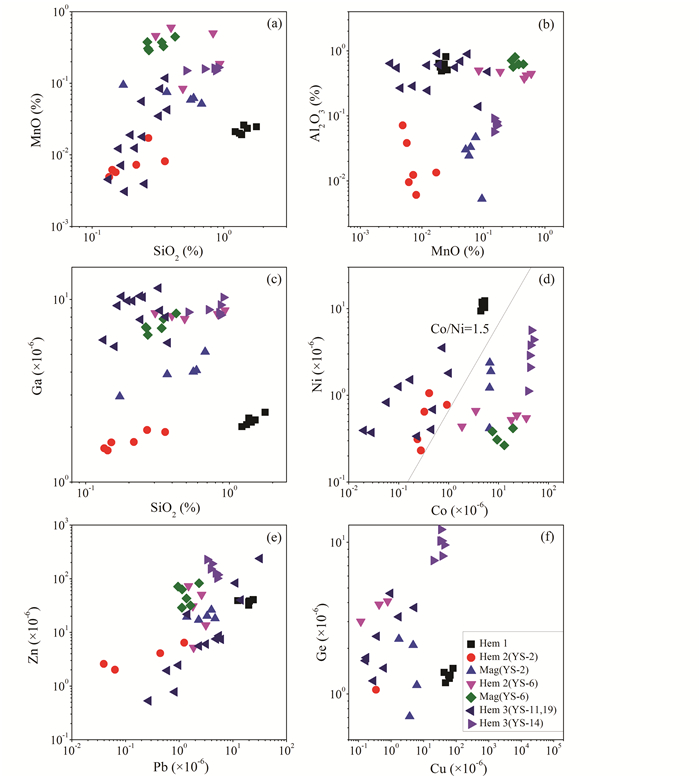
|
图 5 叶山铁矿赤铁矿/磁铁矿的SiO2-MnO (a)、MnO-Al2O3 (b)、SiO2-Ga (c)、Co-Ni (d)、Pb-Zn (e)和Cu-Ge (f)图解 Fig. 5 Plots of SiO2 vs. MnO (a), MnO vs. Al2O3 (b), SiO2 vs. Ga (c), Co vs. Ni (d), Pb vs. Zn (e) and Cu vs. Ge (f) in hematite/magnetite from the Yeshan iron deposit |
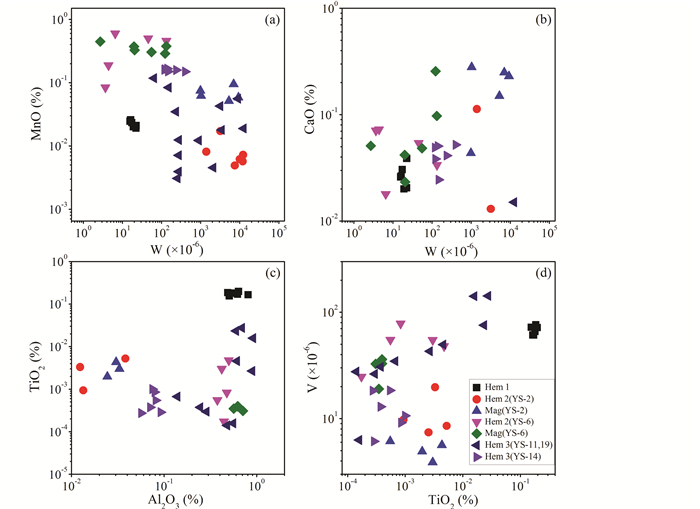
|
图 6 叶山铁矿赤铁矿/磁铁矿的W-MnO (a)、W-CaO (b)、Al2O3-TiO2 (c)和TiO2-V (d)图解 Fig. 6 Plots of W vs. MnO (a), W vs. CaO (b), Al2O3 vs. TiO2 (c) and TiO2 vs. V (d) in hematite/magnetite from the Yeshan iron deposit |
结合上文中SEM观察结果,分析认为Hem 1具有原始沉积特征,代表着黄龙组地层中的沉积铁建造,但受到后期热液影响,发生了重结晶作用,因此化学组分上具有高Si、Al、Ti的特征,与Hem 2、Hem 3在成因上无太多关联。Hem 2、Hem 3具有两种类似的成因,即高W,低SiO2、MnO、Co/Ni比值,代表沉积-热液叠加改造成因(Hem 2SH,Hem 3SH);低W,高SiO2、MnO、Co/Ni比值,代表热液成因(Hem 2H,Hem 3H)。因此Hem 2H与共生磁铁矿(YS-6)在化学成分上具有连续性,而Hem 2SH与其共生磁铁矿(YS-2)在化学成分上具有轻微差异,表明赤铁矿的形成受前驱体化学组成和热液组分叠加影响。同样的,Hem 3H具有较为稳定的化学组成,而Hem 3SH化学组成变化较大,亦体现了前驱体跟热液组分叠加对赤铁矿成因的影响。以上分析排除了Hem 1作为沉积-热液叠加改造前驱体的可能,研究认为当热液中存在大量硅离子时,H4[Si(W3O10)4]能在酸性溶液中与Fe2+、Ca2+、Mn2+稳定共存(刘英俊等,1984),且钨更稳定存在于富硅热液中,但当遇到碳酸盐岩时,溶液中CO32-浓度升高致使其逃逸出热液,故钨的运移、沉淀指示了矿区前驱体可能为一套碳酸盐岩建造。同理,本文亦排除了五通组顶部粉砂质页岩中的赤铁矿透镜体做为该区沉积-热液叠加改造型赤铁矿前驱体的可能性。
4.3 矿床成因Dupuis and Beaudoin(2011)的(Ti+V)-(Ca+Al+Mn)图解被广泛用来判别铁矿床成因类型(曾红等,2014;段士刚等,2014;Chen et al., 2015;Chung et al., 2015;李壮等,2016;Günther et al., 2017),但其普适性也遭到一些学者的怀疑(Cabral and Rosière, 2013),本文铁氧化物投点除少部分落入矽卡岩区和IOCG区内,其余大部分落入图框外围(图 7),主要原因在于铁氧化物TiO2含量太低,这可能跟前驱体化学组成有关。此外,Cabral and Rosière(2013)曾指出(Ti+V)-(Ca+Al+Mn)图解不适用于低温铁矿床,说明本区铁矿化也可能跟低温有关,这也符合锰质矽卡岩形成温度特点(赵一鸣等,1990)及钨矿化多发生于中-高温环境这一认识(任云生等,2010;张振杰等,2011;熊欣等,2015)。林师整(1982)曾对大量磁铁矿的主量元素进行统计,在此基础上绘制了磁铁矿TiO2-Al2O3-(MgO+MnO)三角形成因图解。将本文中磁铁矿及与磁铁矿共生的赤铁矿共同投点作图,其结果基本都落入了矽卡岩或沉积变质区域(图 8),且磁铁矿的分布特征较好地吻合了上文分析结果,即Mag(YS-2)为沉积变质成因(沉积-热液叠加改造成因),Mag(YS-6)为矽卡岩成因(热液成因)。
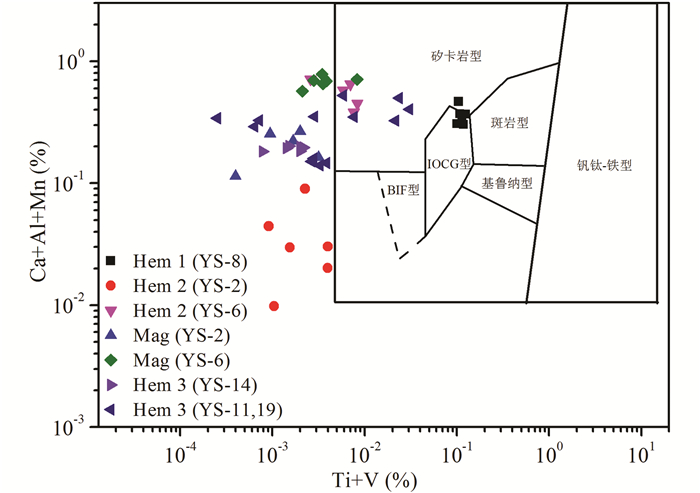
|
图 7 叶山铁矿赤铁矿/磁铁矿(Ti+V)-(Ca+Al+Mn)成因分类图解(底图据Dupuis and Beaudoin, 2011) Fig. 7 Plot of (Ti+V) vs. (Ca+Al+Mn) of hematite/magnetite from the Yeshan iron deposit (after Dupuis and Beaudoin, 2011) |

|
图 8 叶山铁矿赤铁矿(Hem 2)/磁铁矿TiO2-Al2O3-(MgO+MnO)成因分类图解(底图据林师整,1982) Fig. 8 Plot of TiO2-Al2O3-(MgO+MnO) of hematite (Hem 2)/magnetite from the Yeshan iron deposit (after Lin, 1982) |
综上分析认为,叶山铁矿床明显经历了至少两期次的成矿作用:第一期为原始沉积成矿期,第二期为热液叠加改造成矿期。相比较于矽卡岩铁矿床,叶山铁矿床具有矽卡岩矿物组合的特征,但矿区中矿体主要呈层状、似层状,说明热液并未带入大量的铁质组分。因此称之为矽卡岩型,可能并不太适合,更应称之为沉积-热液叠加改造型铁矿床。
4.4 沉积型铁质建造对该矿的制约及其地质意义铜陵矿集区重要的赋矿层位有上石炭统黄龙组、船山组,二叠系中统栖霞组、上统大隆组,三叠系下统和龙山组、南陵湖组(储国正,2003)。本文通过对叶山赤铁矿主微量元素及石英微形貌、微结构的分析,建立了沉积-热液叠加改造型铁矿床的成矿模式,肯定了铜陵黄龙组这套层位中沉积型铁质建造作为前驱体在叶山铁矿床形成过程中的作用与地位。
李红阳等(2004)和曾普胜等(2002)曾在叶山-新桥-高家山一带发现大量石炭纪沉积-喷流块状硫化物矿床,其矿物组合包括硫化物、铁氧化物(赤铁矿、铁碧玉)、碳酸盐(白云石、菱铁矿、菱锰矿)。喻钢等(2007)对钟鸣地区叶山石炭系黄龙组底部砾岩中黄铁矿的Pb同位素研究也支持其为喷流沉积成因。虽有学者对该套层位中出现的矿物组合提出不同成因,如沉积成因(谢巧勤等,2014)、热液成因(张宇等,2013),但目前主流观点认为,石炭纪沉积成矿和燕山期热液成矿是铜陵地区两大成矿体系(陆建军等,2008;侯增谦等,2011;蒋少涌等,2011)。矿体中出现的沉积型赤铁矿(Hem 1)则说明该区黄龙组地层中存在铁氧化物型沉积铁质建造。但前文认为相比较于沉积型赤铁矿(Hem 1),含铁碳酸盐岩更适合作为该矿区前驱体,根据野外地质调查、岩相学分析认为,该矿区前驱体是以菱铁矿为主的碳酸盐岩型沉积铁质建造(图 9)。叶山铁矿的特殊之处在于发育一类锰质矽卡岩矿物,如含锰黑柱石,化学式Ca1.04(Fe1.57Mn0.31Mg0.04)(Fe1.09Al0.01)[Si1.95O]O(OH),该类矽卡岩风化形成了矿区第二大类金属矿石——富锰褐铁矿(Chen et al., 2018),通过富锰褐铁矿的产状恢复了矽卡岩矿物与赤铁矿的共生组合关系,而且矽卡岩矿物具有较高的Al含量,Al3+又容易类质同象替代Fe3+,这可能是导致该类型赤铁矿(Hem 2H、Hem 3SH)较高Al含量的原因。锰质矽卡岩与热液改造型赤铁矿的组合特征正好反映了黄龙组含菱铁矿透镜体白云岩的岩性特征,其与热液发生(1)反应(图 9),从而将富锰菱铁矿(杨竹森等,2004;刘诗贝等,2016)中Mn元素活化带入热液中并交代白云岩形成锰质矽卡岩,碳酸根离子诱导了热液中W元素沉淀。在局部低氧逸度区域发生(2)反应(图 9),形成磁铁矿。而矽卡岩与热液成因赤铁矿/磁铁矿组合特征反映了矽卡岩期氧化物阶段热液中的铁质组分结晶分异形成磁铁矿/赤铁矿、赤铁矿(Hem 3H)。尚未在叶山矿区的黄龙组地层中发现菱铁矿层,可能原因除部分地区缺失黄龙组地层外,还与菱铁矿的热变质程度有关,如矿区白云岩普遍发生不同程度热变质作用或围岩蚀变,如大理岩化、矽卡岩化。
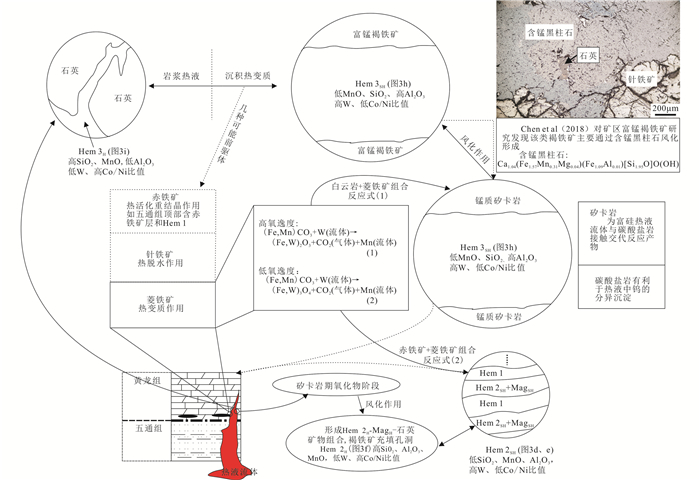
|
图 9 叶山铁矿矿物演化示意图 缩写:Hem-赤铁矿;Mag-磁铁矿;下标:H-热液成因;SH-沉积-热液叠加改造成因 Fig. 9 Schematic diagram of the mineralogical evolution of the Yeshan iron deposit Abbreviations: Hem-hematite; Mag-magnetite. Subscripts: H-hydrothermal genesis; SH-sedimentary-hydrothermal overprinted genesis |
叶山铁矿床的研究佐证了该区黄龙组地层存在沉积铁质建造,且是以菱铁矿为主的铁建造,含赤铁矿、黄铁矿(喻钢等,2007),但是否具有喷流作用仍需商榷。以菱铁矿为前驱体,受热液叠加改造形成赤铁矿(镜铁矿)、磁铁矿。铜陵矿集区是我国“层控矽卡岩型”矿床成矿理论的发源地(常印佛和刘学圭,1983;常印佛等,1991),继而提出了“层控热液型”观点,以叶山铁矿和白牡岭铅锌矿为代表(许卫等,2011)。叶山铁矿表现出层控的特点,是由黄龙组沉积菱铁矿层决定的。铜陵地区黄龙组地层中分布众多的小型铁氧化物型矿床,可能是矿床的赋矿层位中存在菱铁矿为主的沉积铁建造,其作为前驱体提供了主要的成矿物质,而深部的大岩浆房为前驱体的活化提供了能量和少量成矿物质。铜陵地区部分铜金多金属矿床中出现的铁氧化物矿体亦表现出层控的特点,成因可能类似,或者说叶山铁矿的富矿过程只不过是其一个缩影。
5 结论叶山铁矿不同产状赤铁矿(Hem 1、Hem 2、Hem 3)的成分和结构存在明显差异。
Hem 1在主量元素上,具有低Fe,高Si、Al、Ti的特征;除Ga、Ge、Mo、W外,V、Cr、Co、Ni、Cu、Zn、Sr、Ba、Sn、Pb等微量元素含量相对较高。Hem 1酸不溶物的扫描电镜显示石英磨圆度差、表面凹凸不平、有硅质小球粒及风成的断面等具有海陆交互的潮间带成因特征,重结晶特征明显。以上特征说明叶山地区黄龙组地层中存在赤铁矿型铁质建造,并发生了重结晶作用。
根据化学组成及元素相关性图解可将Hem 2、Hem 3分为两类:高W,低Mn、Si、Co/Ni比值(< 1.5),反映沉积-热液叠加改造成因;低W,高Mn、Si、Co/Ni比值(>1.5),反映热液成因。主微量元素特征反映了热液改造过程元素的继承性和热液组分演化过程及其对前驱体的叠加改造影响。
叶山铁矿床符合沉积-热液叠加改造型铁矿床的特征。元素相关性图解排除了Hem 1作为沉积-热液叠加改造成因赤铁矿前驱体的可能性,分析认为叶山地区石炭系黄龙组地层存在以菱铁矿为主的沉积铁建造,其提供了该矿床的主要成矿物质。
致谢 谨借《岩石学报》为庆祝叶大年院士80华诞专辑出版之际,衷心地感谢叶大年院士10多年来给予合肥工业大学纳米矿物与环境材料研究团队的关心、指导和帮助。赤铁矿的LA-ICP-MS分析得到了合肥工业大学资源与环境工程学院矿物原位分析实验室汪方跃老师的大力支持和帮助,石英的SEM分析得到了合肥工业大学分析测试中心张强老师的大力支持与帮助。
Cabral AR and Rosière CA. 2013. The chemical composition of specular hematite from Tilkerode, Harz, Germany:Implications for the genesis of hydrothermal hematite and comparison with the Quadrilátero Ferrífero of Minas Gerais, Brazil. Mineralium Deposita, 48(7): 907-924. DOI:10.1007/s00126-013-0459-2 |
Chang YF and Liu XG. 1983. On strata-bound skarn deposits. Mineral Deposits, 2(1): 11-20. |
Chang YF, Liu XP and Wu CY. 1991. The Copper-iron Belt of the Lower and Middle Reaches of the Changjiang River. Beijing: Geological Publishing House: 1-379.
|
Chang YF, Zhou TF and Fan Y. 2012. Polygenetic compound mineralization and tectonic evolution:Study in the Middle-Lower Yangtze River Valley Metallogenic Belt. Acta Petrologica Sinica, 28(10): 3067-3075. |
Chen P, Chen TH, Xie QQ, Xu L, Liu HB and Zhou YF. 2018. Mineralogy and geochemistry of limonite as a weathering product of ilvaite in the Yeshan iron deposit, Tongling, China. Clays and Clay Minerals, 66(2): 190-207. DOI:10.1346/CCMN.2018.064102a |
Chen WT, Zhou MF, Li XC, Gao JF and Hou KJ. 2015. In-situ LA-ICP-MS trace elemental analyses of magnetite:Cu-(Au, Fe) deposits in the Khetri Copper Belt in Rajasthan Province, NW India. Ore Geology Reviews, 65: 929-939. DOI:10.1016/j.oregeorev.2014.09.035 |
Chu GZ.2003.The metallogenetic system and its implications for deposit exploration in the Cu and Au orefield of Shizishan, Tongling.Ph.D.Dissertation.Beijing: China University of Geosciences, 1-149(in Chinese with English summary)
|
Chung D, Zhou MF, Gao JF and Chen WT. 2015. In-situ LA-ICP-MS trace elemental analyses of magnetite:The Late Palaeoproterozoic Sokoman iron formation in the Labrador Trough, Canada. Ore Geology Reviews, 65: 917-928. DOI:10.1016/j.oregeorev.2014.09.030 |
Dare SAS, Barnes SJ and Beaudoin G. 2012. Variation in trace element content of magnetite crystallized from a fractionating sulfide liquid, Sudbury, Canada:Implications for provenance discrimination. Geochimica et Cosmochimica Acta, 88: 27-50. DOI:10.1016/j.gca.2012.04.032 |
Du SG, Du JG, Xu W, Sun CY and Wu LB. 2012. Discovery of petromictic conglomerate between early and late Carboniferous strata in the Tongling area, Anhui Province. Journal of Stratigraphy, 36(3): 579-586. |
Duan C, Li YH, Yuan SD, Hu MY, Zhao LH, Chen XD, Zhang C and Liu JL. 2012. Geochemical characteristics of magnetite from Washan iron deposit in Ningwu ore district and its constraints on ore-forming. Acta Petrologica Sinica, 28(1): 243-257. |
Duan C, Li YH, Mao JW, Wang CL, Yang BY, Hou KJ, Wang Q and Li W. 2017. Study on the ore-forming process of the Heshangqiao IOA deposit in the Ningwu ore district:Insight from magnetite LA-ICP-MS in-situ analysis data. Acta Petrologica Sinica, 33(11): 3471-3483. |
Duan SG, Dong MH, Zhang ZH, Jiang ZS and Li FM. 2014. A LA-ICP-MS analysis of elements in magnetite from Dunde iron deposit in western Tianshan Mountains, Xinjiang:Constraints on genesis of the deposit. Mineral Deposits, 33(6): 1325-1337. |
Dupuis C and Beaudoin G. 2011. Discriminant diagrams for iron oxide trace element fingerprinting of mineral deposit types. Mineralium Deposita, 46(4): 319-335. DOI:10.1007/s00126-011-0334-y |
Guo ZS. 1957. The skarn type of copper ore deposits of the Lower Yangtze, China. Acta Geologica Sinica, 37(1): 1-10. |
Günther T, Klemd R, Zhang X, Horn I and Weyer S. 2017. In-situ trace element and Fe-isotope studies on magnetite of the volcanic-hosted Zhibo and Chagangnuoer iron ore deposits in the Western Tianshan, NW China. Chemical Geology, 453: 111-127. DOI:10.1016/j.chemgeo.2017.02.001 |
Higgs R. 1979. Quartz grain surface features of Mesozoic-Cenozoic sands from the Labrador and western Greenland continental margins. Journal of Sedimentary Petrology, 49: 599-610. |
Hou T, Zhang ZC and Du YS. 2010. Deep ore magma-hydrothermal system of Zhonggu ore field in southern part of Ningwu Basin. Earth Science Frontiers, 17(1): 186-194. |
Hou ZQ, Yang ZS, Lv QT, Zeng PS, Xie YL, Meng YF, Tian SH, Xu WY, Li HY, Jiang ZP, Wang XC and Yao XD. 2011. The large-scale Dongguashan deposit, Shizishan district in East China:Carboniferous SEDEX-type massive sulfides overprinted by Late Jurassic skarn Cu mineralization. Acta Geologica Sinica, 85(5): 659-686. |
Huang XW, Gao JF, Qi L, Meng YM, Wang YC and Dai ZH. 2016. In-situ LA-ICP-MS trace elements analysis of magnetite:The Fenghuangshan Cu-Fe-Au deposit, Tongling, eastern China. Ore Geology Reviews, 72: 746-759. DOI:10.1016/j.oregeorev.2015.09.012 |
Jiang SY, Ding QF, Yang SY, Zhu ZY, Sun MZ, Sun Y and Bian LZ. 2011. Discovery and significance of carbonate mud mounds from Cu-polymetallic deposits in the Middle and Lower Yangtze Metallogenic Belt:Examples from the Wushan and Dongguashan deposits. Acta Geologica Sinica, 85(5): 744-756. |
Krinsley DH and Doornkamp JC. 1973. Atlas of Quartz Sand Surface Textures. Cambridge: Cambridge University Press: 1-102.
|
Li BL and Xie YH. 1984. Origin, classification, and ore-forming model of Ningwu type iron deposits in Ningwu area. Chinese Science in China (Series B), 14(1): 80-86. |
Li HY, Yang ZS, Meng YF, Zeng PS and Xu WY. 2004. Geological characteristics of massive sulfide deposits in Tongling Ore Concentration Area, Anhui Province. Mineral Deposits, 23(3): 327-333. |
Li Y, Li JW, Li XH, Selby D, Huang GH, Chen LJ and Zheng K. 2017. An Early Cretaceous carbonate replacement origin for the Xinqiao stratabound massive sulfide deposit, Middle-Lower Yangtze Metallogenic Belt, China. Ore Geology Reviews, 80: 985-1003. DOI:10.1016/j.oregeorev.2016.08.017 |
Li YH, Duan C, Han D, Liu F, Wan DF and Wang CY. 2017. Oxygen isotopic discriminant marker of magmatic iron deposits:Ningwu porphyrite iron ore as an example. Acta Petrologica Sinica, 33(11): 3411-3421. |
Li Z, Tang JX, Wang LQ, Yang Y and Zhong Y. 2016. Geochemistry of magnetites from the Lietinggang iron polymetallic deposit in Tibet and its geological significance. Acta Petrologica et Mineralogica, 35(5): 821-839. |
Lin SZ. 1982. A contribution to the chemistry, origin and evolution of magnetite. Acta Mineralogica Sinica, (3): 8-16. |
Liu SB, Xu L, Chen P, Xie QQ, Chen TH and Liu HB. 2016. Mineralogy of the limonite ore from the Xinqiao sulfide iron deposit in the Tongling Ore Concentration Area of Anhui Province and its implications. Acta Petrologica et Mineralogica, 35(3): 531-542. |
Liu YJ, Cao LM, Li ZL, Wang HN, Chu TQ and Zhang JR. 1984. Geochemistry of Elements. Beijing: Science Press: 1-548.
|
Liu YS, Hu ZC, Gao S, Günther D, Xu J, Gao CG and Chen HH. 2008. In situ analysis of major and trace elements of anhydrous minerals by LA-ICP-MS without applying an internal standard. Chemical Geology, 257(1-2): 34-43. DOI:10.1016/j.chemgeo.2008.08.004 |
Lu JJ, Guo WM, Chen WF, Jiang SY, Li J, Yan XR and Xu YW. 2008. A metallogenic model for the Dongguashan Cu-Au deposit of Tongling, Anhui Province. Acta Petrologica Sinica, 24(8): 1857-1864. |
Mao JW, Shao YJ, Xie GQ, Zhang JD and Chen YC. 2009. Mineral deposit model for porphyry-skarn polymetallic copper deposits in Tongling Ore Concentration District of Middle-Lower Yangtze Valley Metallogenic Belt. Mineral Deposits, 28(2): 109-119. |
Nie LQ, Zhou TF, Fan Y, Zhang YJ, Cooke D and White N. 2017. Geology, geochemistry and genesis of the Makou magnetite-apatite deposit in the Luzong volcanic basin, Middle-Lower Yangtze River Valley Metallogenic Belt, eastern China. Ore Geology Reviews, 91: 264-277. DOI:10.1016/j.oregeorev.2017.09.022 |
Pan YM and Dong P. 1999. The Lower Changjiang (Yangzi/Yangtze River) metallogenic belt, East China:Intrusion-and wall rock-hosted Cu-Fe-Au, Mo, Zn, Pb, Ag deposits. Ore Geology Reviews, 15(4): 177-242. DOI:10.1016/S0169-1368(99)00022-0 |
Ren GL, Wang H, Liu JP, Wang B, Wu YF and Huang CY. 2012. Geochemical characteristics and genesis of Taochong iron deposit in Fanchang district, Anhui Province, China. Earth Science Frontiers, 19(4): 82-95. |
Ren YS, Zhao HL, Lei E, Wang H, Ju N and Wu CZ. 2010. Trace element and rare earth element geochemistry of the scheelite and ore genesis of the Yangjingou large scheelite deposit in Yanbian area, northeastern China. Acta Petrologica Sinica, 26(12): 3720-3726. |
Tang YC, Wu YC, Chu GZ, Xing FM, Wang YM, Cao FY and Chang YF. 1998. Geology of Copper-gold Polymetallic Deposits in the along Changjiang Area of Anhui Province. Beijing: Geological Publishing House: 1-351.
|
Teng X, Huang DZ, Lu Y and Wang L. 2018. Ore-forming fluid and mineralization of the Taocun magnetite deposit in the Ningwu basin. Geotectonica et Metallogenia, 42(1): 73-83. |
Vos K, Vandenberghe N and Elsen J. 2014. Surface textural analysis of quartz grains by scanning electron microscopy (SEM):From sample preparation to environmental interpretation. Earth-Science Reviews, 128: 93-104. DOI:10.1016/j.earscirev.2013.10.013 |
Wang JB.2016.Characteristics and origin of the Baocun skarn gold deposit, Tongling, Anhui Province.Master Degree Thesis.Beijing: China University of Geosciences, 1-76(in Chinese with English summary)
|
Wang Y, Zhu XK, Mao JW and Cheng YB. 2014. Preliminary Fe isotopic study of Gushan ore magma deposit in Anhui Province. Mineral Deposits, 33(4): 689-696. |
Xie QQ, Chen TH, Fan ZL, Xu XC, Zhou YF, Shi WB and Xie JJ. 2014. Morphogical charactrtistics and genesis of colloform pyrite in Xinqiao Fe-S deposit, Tongling, Anhui Province. Scientia Sinica Terrae, 44(12): 2665-2674. |
Xiong X, Xu WY and Wen CH. 2015. Fluid characteristics and genesis of Xianglushan skarn scheelite deposit in Xiushui, Jiangxi Province. Mineral Deposits, 34(5): 1046-1056. |
Xu G and Lin X. 2000. Geology and geochemistry of the Changlongshan skarn iron deposit, Anhui Province, China. Ore Geology Reviews, 16(1-2): 91-106. DOI:10.1016/S0169-1368(99)00025-6 |
Xu W, Ding XG, Wu LB, Wang KY and Ding N. 2011. Metallogenic features and ore prospecting potential at the north rim of the Tongling uplift, Anhui. Geology of Anhui, 21(2): 138-142. |
Yang ZS, Hou ZQ, Meng YF, Zeng PS, Li HY, Xu WY, Tian SH, Wang XC, Yao XD and Jiang ZP. 2004. Spatial-temporal structures of Hercynian exhalitive-sedimentary fluid system in Tongling Ore Concentration Area, Anhui Province. Mineral Deposits, 23(3): 281-297. |
Ye CL, Liu JR, Wang XC and Jiang SY. 2010. Sedimentary palaeogeography of the Early Carboniferous in Tongling and its adjacent areas in Anhui Province. Journal of Palaeogeography, 12(4): 371-383. |
Yu G, Lu J, Zhang CH, Chen JF and Liu YL. 2007. Pb isotope determination and the metallogenetic material source of the Shimenkou pyrite deposit, Anhui Province. Geology of Anhui, 17(2): 85-89. |
Zang WS, Wu GG, Zhang D and Liu AH. 2004. Xinqiao iron-deposit field in Tongling, Anhui:Geologic and geochemical characteristics and genesis. Geotectonica et Metallogenia, 28(2): 187-193. |
Zeng H, Chai FM, Zhou G, Geng XX, Li Q, Meng QP and Xu LL. 2014. Mineralogy of skarn and magnetite of the Yamansu iron deposit and its geological significance. Geology in China, 41(6): 1914-1928. |
Zeng PS, Pei RF, Hou ZQ, Meng YF, Yang ZS, Wang XC, Tian SH, Xu WY and Jiang ZP. 2002. SEDEX-type massive sulfide deposits in Tongling block, Anhui, China. Mineral Deposits, 21(Suppl.): 532-535. |
Zhai YS, Yao SZ, Lin XD, Zhou XR, Wan TF, Jin FQ and Zhou ZG. 1992. Fe-Cu(Au) Metallogeny of the Middle-Lower Changjiang Region. Beijing: Geological Publishing House: 1-235.
|
Zhang LJ, Zhou TF, Fan Y, Yuan YF, Qian B and Ma L. 2011. A LA-ICP-MS study of apatite from the Taocun magnetite-apatite deposit, Ningwu basin. Acta Geologica Sinica, 85(5): 834-848. |
Zhang Y, Shao YJ, Zhou X, Liu ZF and Zheng MH. 2013. Major and trace elements' characteristics of colloidal pyrites in Xinqiao Cu-S-Fe deposit, Tongling, Anhui Province, China. The Chinese Journal of Nonferrous Metals, 23(12): 3492-3502. |
Zhang Y, Shao YJ, Li HB and Liu ZF. 2017. Genesis of the Xinqiao Cu-S-Fe-Au deposit in the Middle-Lower Yangtze River Valley metallogenic belt, eastern China:Constraints from U-Pb-Hf, Rb-Sr, S, and Pb isotopes. Ore Geology Reviews, 86: 100-116. DOI:10.1016/j.oregeorev.2017.02.014 |
Zhang ZJ, Lv XB and Chen C. 2011. Characteristics and evolution of ore-forming fluids in Zhongbao tungsten deposit, Xinjiang. Mineral Deposits, 30(6): 1058-1068. |
Zhao WW and Zhou MF. 2015. In-situ LA-ICP-MS trace elemental analyses of magnetite:The Mesozoic Tengtie skarn Fe deposit in the Nanling range, South China. Ore Geology Reviews, 65: 872-883. DOI:10.1016/j.oregeorev.2014.09.019 |
Zhao YM, Lin WW, Bi CS, Li DX and Jiang CJ. 1990. Skarn Deposits of China. Beijing: Geological Publishing House: 1-354.
|
Zhou TF, Yuan F, Fan Y, Xie JC and Zhang X. 2009. A Practical Approach of Ore Deposits in Tongling Ore Concentration Area. Beijing: Geological Publishing House: 1-139.
|
Zhou TF, Zhang LJ, Yuan F, Fan Y and Cooke DR. 2010. LA-ICP-MS in situ trace element analysis of pyrite from the Xinqiao Cu-Au-S deposit in Tongling, Anhui, and its constraints on the ore genesis. Earth Science Frontiers, 17(2): 306-319. |
Zhou TF, Wu MG, Fan Y, Duan C, Yuan F, Zhang LJ, Liu J, Qian B, Pirajno F and Cooke DR. 2011. Geological, geochemical characteristics and isotope systematics of the Longqiao iron deposit in the Lu-Zong volcano-sedimentary basin, Middle-Lower Yangtze (Changjiang) River Valley, eastern China. Ore Geology Reviews, 43(1): 154-169. DOI:10.1016/j.oregeorev.2011.04.004 |
Zhu X. 1951. Types and genesis of iron deposits in the south of Anhui. Geological Review, 16(2): 158-159. |
Zhu ZQ. 1987. Study on migration of the iron-rich magma of the Meishan iron deposit. Scientia Geologica Sinica, (3): 276-281. |
常印佛, 刘学圭. 1983. 关于层控式矽卡岩型矿床——以安徽省内下扬子坳陷中一些矿床为例. 矿床地质, 2(1): 11-20. |
常印佛, 刘湘培, 吴言昌. 1991. 长江中下游铜铁成矿带. 北京: 地质出版社: 1-379.
|
常印佛, 周涛发, 范裕. 2012. 复合成矿与构造转换——以长江中下游成矿带为例. 岩石学报, 28(10): 3067-3075. |
储国正.2003.铜陵狮子山铜金矿田成矿系统及其找矿意义.博士学位论文.北京: 中国地质大学, 1-149
|
杜森官, 杜建国, 许卫, 孙乘云, 吴礼彬. 2012. 安徽铜陵地区早、晚石炭世地层之间砾岩的发现. 地层学杂志, 36(3): 579-586. |
段超, 李延河, 袁顺达, 胡明月, 赵令浩, 陈小丹, 张成, 刘佳林. 2012. 宁芜矿集区凹山铁矿床磁铁矿元素地球化学特征及其对成矿作用的制约. 岩石学报, 28(1): 243-257. |
段超, 李延河, 毛景文, 王丛林, 杨秉阳, 侯可军, 王倩, 李伟. 2017. 宁芜和尚桥铁氧化物-磷灰石矿床(IOA)成矿过程研究:来自磁铁矿LA-ICP-MS原位分析的证据. 岩石学报, 33(11): 3471-3483. |
段士刚, 董满华, 张作衡, 蒋宗胜, 李凤鸣. 2014. 西天山敦德铁矿床磁铁矿原位LA-ICP-MS元素分析及意义. 矿床地质, 33(6): 1325-1337. DOI:10.3969/j.issn.0258-7106.2014.06.011 |
郭宗山. 1957. 扬子江下游某些矽嘎岩型铜矿床. 地质学报, 37(1): 1-10. |
侯通, 张招崇, 杜杨松. 2010. 宁芜南段钟姑矿田的深部矿浆-热液系统. 地学前缘, 17(1): 186-194. |
侯增谦, 杨竹森, 吕庆田, 曾普胜, 谢玉玲, 蒙义峰, 田世洪, 徐文艺, 李红阳, 姜章平, 王训成, 姚孝德. 2011. 安徽铜陵冬瓜山大型铜矿:海底喷流-沉积与矽卡岩化叠加复合成矿过程. 地质学报, 85(5): 659-686. |
蒋少涌, 丁清峰, 杨水源, 朱志勇, 孙明志, 孙岩, 边立曾. 2011. 长江中下游成矿带铜多金属矿床中灰泥丘的发现及其意义——以武山和冬瓜山铜矿为例. 地质学报, 85(5): 744-756. |
李秉伦, 谢奕汉. 1984. 宁芜地区宁芜型铁矿的成因、分类和成矿模式. 中国科学(B辑), 14(1): 80-86. |
李红阳, 杨竹森, 蒙义峰, 曾普胜, 徐文艺. 2004. 铜陵矿集区块状硫化物矿床地质特征. 矿床地质, 23(3): 327-333. DOI:10.3969/j.issn.0258-7106.2004.03.006 |
李延河, 段超, 韩丹, 刘锋, 万德芳, 王成玉. 2017. 矿浆型铁矿的氧同位素判别标志:以宁芜玢岩铁矿为例. 岩石学报, 33(11): 3411-3421. |
李壮, 唐菊兴, 王立强, 杨毅, 钟毅. 2016. 西藏列廷冈铁多金属矿床磁铁矿元素地球化学特征及地质意义. 岩石矿物学杂志, 35(5): 821-839. DOI:10.3969/j.issn.1000-6524.2016.05.006 |
林师整. 1982. 磁铁矿矿物化学、成因及演化的探讨. 矿物学报, (3): 8-16. |
刘诗贝, 徐亮, 陈平, 谢巧勤, 陈天虎, 刘海波. 2016. 铜陵新桥矿田褐铁矿矿物组成及成因. 岩石矿物学杂志, 35(3): 531-542. DOI:10.3969/j.issn.1000-6524.2016.03.012 |
刘英俊, 曹励明, 李兆麟, 王鹤年, 储同庆, 张景荣. 1984. 元素地球化学. 北京: 科学出版社: 1-548.
|
陆建军, 郭维民, 陈卫锋, 蒋少涌, 李娟, 颜晓蓉, 徐兆文. 2008. 安徽铜陵冬瓜山铜(金)矿床成矿模式. 岩石学报, 24(8): 1857-1864. |
毛景文, 邵拥军, 谢桂青, 张建东, 陈毓川. 2009. 长江中下游成矿带铜陵矿集区铜多金属矿床模型. 矿床地质, 28(2): 109-119. DOI:10.3969/j.issn.0258-7106.2009.02.001 |
任广利, 王核, 刘建平, 王彪, 吴玉峰, 黄朝阳. 2012. 安徽繁昌地区桃冲铁矿床地球化学特征及矿床成因研究. 地学前缘, 19(4): 82-95. |
任云生, 赵华雷, 雷恩, 王辉, 鞠楠, 吴昌志. 2010. 延边杨金沟大型钨矿床白钨矿的微量和稀土元素地球化学特征与矿床成因. 岩石学报, 26(12): 3720-3726. |
唐永成, 吴言昌, 储国正, 邢凤鸣, 王永敏, 曹奋扬, 常印佛. 1998. 安徽沿江地区铜金多金属矿床地质. 北京: 地质出版社: 1-351.
|
滕霞, 黄德志, 卢洋, 汪龙. 2018. 宁芜陶村磁铁矿矿床成矿流体及成矿作用. 大地构造与成矿学, 42(1): 73-83. |
王剑波.2016.安徽铜陵包村矽卡岩型金矿特征和成因.硕士学位论文.北京: 中国地质大学, 1-76
|
王跃, 朱祥坤, 毛景文, 程彦博. 2014. 安徽姑山矿浆型铁矿床Fe同位素初步研究. 矿床地质, 33(4): 689-696. DOI:10.3969/j.issn.0258-7106.2014.04.002 |
谢巧勤, 陈天虎, 范子良, 徐晓春, 周跃飞, 石文兵, 谢晶晶. 2014. 铜陵新桥硫铁矿床中胶状黄铁矿微尺度观察及其成因探讨. 中国科学(地球科学), 44(12): 2665-2674. |
熊欣, 徐文艺, 文春华. 2015. 江西香炉山矽卡岩型白钨矿矿床成因与流体特征. 矿床地质, 34(5): 1046-1056. |
许卫, 丁希国, 吴礼彬, 王克友, 丁宁. 2011. 安徽铜陵隆起北缘的成矿作用特征及找矿潜力. 安徽地质, 21(2): 138-142. DOI:10.3969/j.issn.1005-6157.2011.02.011 |
杨竹森, 侯增谦, 蒙义峰, 曾普胜, 李红阳, 徐文艺, 田世洪, 王训诚, 姚孝德, 姜章平. 2004. 安徽铜陵矿集区海西期喷流沉积流体系统时空结构. 矿床地质, 23(3): 281-297. DOI:10.3969/j.issn.0258-7106.2004.03.003 |
叶春林, 刘家润, 王训诚, 蒋少涌. 2010. 安徽铜陵及邻区早石炭世沉积古地理. 古地理学报, 12(4): 371-383. |
喻钢, 卢佳, 张成火, 陈江峰, 刘玉龙. 2007. 安徽峙门口矿床黄铁矿的Pb同位素测定和成矿物质来源探讨. 安徽地质, 17(2): 85-89. DOI:10.3969/j.issn.1005-6157.2007.02.002 |
臧文栓, 吴淦国, 张达, 刘爱华. 2004. 铜陵新桥铁矿田地质地球化学特征及成因浅析. 大地构造与成矿学, 28(2): 187-193. DOI:10.3969/j.issn.1001-1552.2004.02.011 |
曾红, 柴凤梅, 周刚, 耿新霞, 李强, 孟庆鹏, 徐璐璐. 2014. 新疆雅满苏铁矿床矽卡岩和磁铁矿矿物学特征及其地质意义. 中国地质, 41(6): 1914-1928. DOI:10.3969/j.issn.1000-3657.2014.06.010 |
曾普胜, 裴荣富, 侯增谦, 蒙义峰, 杨竹森, 王训诚, 田世洪, 徐文艺, 姜章平. 2002. 安徽铜陵地块沉积-喷流块状硫化物矿床. 矿床地质, 21(增): 532-535. |
张乐骏, 周涛发, 范裕, 张袁峰, 钱兵, 马良. 2011. 宁芜盆地陶村铁矿床磷灰石的LA-ICP-MS研究. 地质学报, 85(5): 834-848. |
张宇, 邵拥军, 周鑫, 刘忠法, 郑明泓. 2013. 安徽铜陵新桥铜硫铁矿床胶状黄铁矿主、微量元素特征. 中国有色金属学报, 23(12): 3492-3502. |
张振杰, 吕新彪, 陈超. 2011. 新疆忠宝钨矿床成矿流体特征与演化. 矿床地质, 30(6): 1058-1068. DOI:10.3969/j.issn.0258-7106.2011.06.006 |
赵一鸣, 林文蔚, 毕承思, 李大新, 蒋崇俊. 1990. 中国矽卡岩矿床. 北京: 地质出版社: 1-354.
|
翟裕生, 姚书振, 林新多, 周珣若, 万天丰, 金福全, 周宗桂. 1992. 长江中下游地区铁铜(金)成矿规律. 北京: 地质出版社: 1-235.
|
周涛发, 袁峰, 范裕, 谢建成, 张鑫. 2009. 铜陵矿集区矿床学实践教程. 北京: 地质出版社: 1-139.
|
周涛发, 张乐骏, 袁峰, 范裕, Cooke DR. 2010. 安徽铜陵新桥Cu-Au-S矿床黄铁矿微量元素LA-ICP-MS原位测定及其对矿床成因的制约. 地学前缘, 17(2): 306-319. |
朱夏. 1951. 安徽南部铁矿之种类及成因(节要). 地质论评, 16(2): 158-159. |
朱增青. 1987. 梅山铁矿富铁熔浆运移的探讨. 地质科学, (3): 276-281. |
 2019, Vol. 35
2019, Vol. 35


